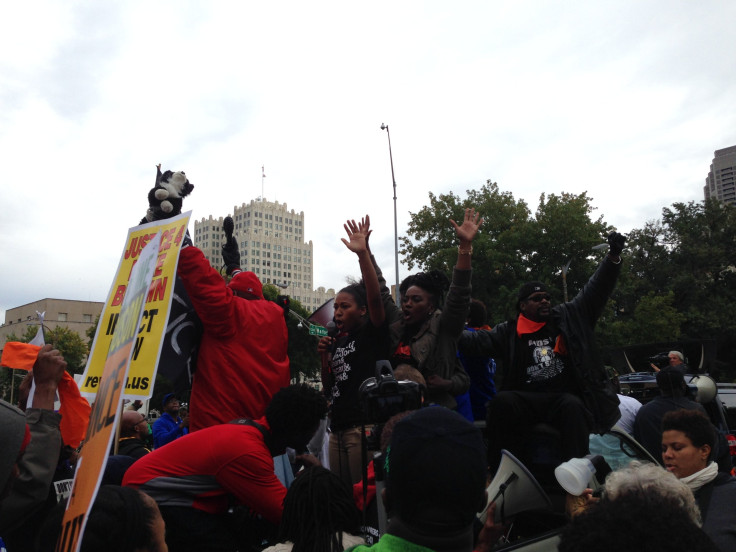Ferguson October Protests: Mike Brown Shooting Draws Crowds From Beyond St. Louis

ST. LOUIS -- Adrian Elim marched down Market Street in solidarity with the hundreds of other protesters who had turned up to support slain teenagers Mike Brown and Vonderrit Myers Jr. Clad in a Malcolm X T-shirt, Elim lagged behind the rest of the crowd to decry young black American youths who respond to instances of police brutality and shootings with an apathetic shrug. A protest organizer motioned for Elim to keep up, but he couldn't stop talking.
The 22-year-old isn’t from St. Louis or Ferguson, Missouri, but was one of dozens of protesters from other states who felt the need to march for justice Saturday for Brown and Myers, joining hundreds of others to protest the two police-involved shootings in the St. Louis area.
“We have to get rid of the narrative that black people need to be saved,” said Elim, who drove 13 hours straight from Rochester, New York, to participate in the largest protest in the city since Brown's death two months ago. Myers was shot and killed by an off-duty officer earlier this week in the Shaw neighborhood of St. Louis. “We can do the saving ourselves.”
Elim is part of a group of black youths in Rochester who formed the organization Building Leadership and Community Knowledge, or B.L.A.C.K., in the city in response to the Ferguson shooting and cases of police brutality and shootings across the country. Elim, 24, said their goal is for black youth to become more active and change the power structures in their communities. In Ferguson, for example, the mayor and police chief are white even though the St. Louis suburb is predominantly black.
Part of the problem, Elim said, is that black youth are not taught about their past beyond slavery in schools. If they knew about African-American achievements, young black people would be more inspired, he said.
Last month, Rochester had its own controversial police incident. Clem Long, 36, was punched in the face and body during a confrontation with police that was caught on video. Rochester police said Long resisted arrest after the officer allegedly saw him in possession of a marijuana cigarette. The video shows the officer punching Long. Police said Long injured the officer, but that wasn’t captured in the video.
Elim demonstrated after the incident because, he said, it showed Brown’s shooting wasn’t an isolated occurrence. “It’s essential we focus on the fact this is a problem with the system,” he said of police interactions with blacks. “Capitalism does not function without oppression.”
The Rochester resident also participated in protests Friday night in Shaw that he said were more contentious than the peaceful demonstration Saturday. Elim said authorities had tactical gear and tapped their batons as if they were bracing for protesters to get rowdy.
“This looks a lot different from what we saw last night,” Elim said of the rally. “Here the cops aren’t scared. It’s very organized. It’s very contained.”
Elim said the mobilization of black youth in the wake of Brown’s and Myers’ deaths is not a fleeting phenomenon. “This isn’t a trend. This is not a fad,” Elim said. “This is our lives.”
© Copyright IBTimes 2024. All rights reserved.






















